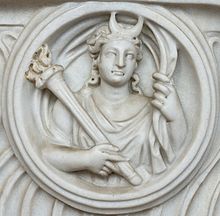Selene
| Selene | |
|---|---|
| Goddess of the Moon | |

Detail of Selene from a Roman sarcophagus
|
|
| Abode | Sky |
| Symbol | Crescent, raised cloak, bull, rooster, dog, and torch |
| Consort | Endymion |
| Parents | Hyperion and Theia |
| Siblings | Helios and Eos |
| Children | Fifty daughters to Endymion; Pandia and Ersa to Zeus |
| Roman equivalent | Luna |
In Greek mythology, Selene (/sᵻˈliːni/; Greek Σελήνη [selɛ̌ːnɛː] 'moon';) is the goddess of the moon. She is the daughter of the Titans Hyperion and Theia, and sister of the sun-god Helios, and Eos, goddess of the dawn. She drives her moon chariot across the heavens. Several lovers are attributed to her in various myths, including Zeus, Pan, and the mortal Endymion. In classical times, Selene was often identified with Artemis, much as her brother, Helios, was identified with Apollo. Both Selene and Artemis were also associated with Hecate, and all three were regarded as lunar goddesses, although only Selene was regarded as the personification of the moon itself. Her Roman equivalent is Luna.
The etymology of Selene is uncertain, but if the name is of Greek origin, it is likely connected to the word selas (σέλας), meaning "light".
Just as Helios, from his identification with Apollo, is called Phoebus ("bright"), Selene, from her identification with Artemis, is also commonly referred to by the epithet Phoebe (feminine form). The original Phoebe of Greek mythology is Selene's aunt, the Titaness mother of Leto and Asteria, and grandmother of Apollo, Artemis, and Hecate. Also from Artemis, Selene was sometimes called "Cynthia".
...
Wikipedia
